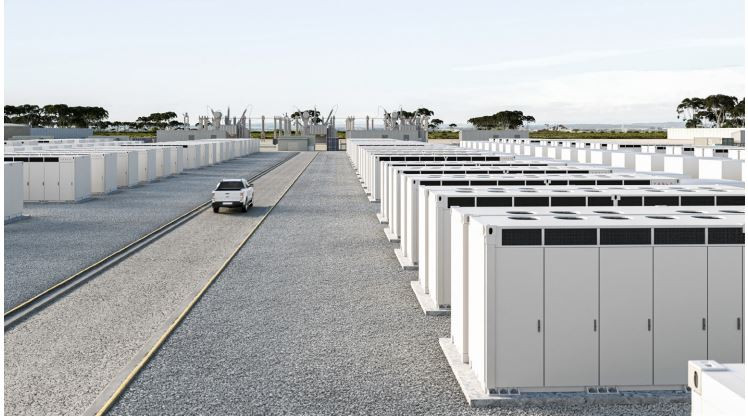China's EV Powerhouse: Assessing America's Readiness For Global Competition.

Table of Contents
China's EV Dominance: A Deep Dive
China's dominance in the EV market isn't accidental; it's a result of a carefully orchestrated strategy combining massive production capacity, substantial government support, and impressive technological advancements.
Massive Production Capacity and Economies of Scale:
- Gigafactories and Manufacturing Prowess: China boasts a vast network of EV manufacturing facilities, often operating at significantly larger scales than their American counterparts, leading to substantial economies of scale. This allows Chinese manufacturers to produce EVs at lower costs.
- Battery Production Dominance: China controls a significant portion of the global supply chain for EV batteries, a crucial component impacting overall vehicle cost. This control over raw materials and manufacturing processes provides a competitive advantage.
- Key Players and Market Share: Companies like BYD, NIO, Xpeng, and others are capturing significant market share both domestically and internationally. BYD, for instance, consistently ranks among the world's top EV sellers.
- Sales Figures: China's domestic EV sales consistently outpace those of any other country, demonstrating the strength of its home market and providing a crucial springboard for global expansion.
Government Support and Subsidies:
The Chinese government has heavily invested in its EV sector, providing significant support through various channels:
- R&D Funding: Massive investments in research and development have fueled technological innovations, accelerating the development of advanced battery technologies and autonomous driving systems.
- Infrastructure Development: China has aggressively expanded its charging infrastructure network, making EV ownership more practical for consumers. This contrasts with the comparatively slower infrastructure build-out in the US.
- Consumer Incentives: Government subsidies and tax breaks have stimulated consumer demand, creating a robust domestic market for EVs. These incentives are often more generous than those offered in the US.
Technological Advancements and Innovation:
China is rapidly advancing in several key areas of EV technology:
- Battery Technology: Significant breakthroughs in battery density, charging speed, and cost reduction are emanating from Chinese research institutions and companies.
- Charging Infrastructure: China's vast and rapidly expanding network of charging stations, including fast-charging capabilities, is a significant competitive advantage.
- Autonomous Driving: Chinese companies are actively developing and deploying advanced autonomous driving systems, though the US still holds a lead in certain aspects of this technology.
America's Current EV Landscape: Strengths and Weaknesses
The US EV landscape presents a mixed bag of strengths and weaknesses in its competition with China's EV powerhouse.
Existing Strengths:
- Established Automotive Industry: The US possesses a long-standing automotive industry with established expertise in manufacturing, design, and engineering.
- Strong R&D Capabilities: American companies and research institutions are at the forefront of certain EV technologies, particularly in battery chemistry and software development.
- Consumer Demand: Growing consumer awareness and demand for EVs create a strong foundation for market growth.
- Key Players: Companies like Tesla, General Motors, and Ford are major players in the global EV market, although they still face significant challenges.
Critical Weaknesses:
- Higher Production Costs: Manufacturing EVs in the US is generally more expensive than in China due to higher labor costs and regulatory hurdles.
- Supply Chain Dependence: The US relies heavily on foreign sources for crucial EV battery materials, creating vulnerabilities in the supply chain.
- Slow Infrastructure Development: The US lags behind China in the development of a comprehensive nationwide EV charging infrastructure.
- Skills Gap: A potential skills gap in the EV manufacturing sector might hinder the ability to rapidly scale up production.
- Regulatory Landscape: A less supportive regulatory environment compared to China may slow down the growth of the US EV industry.
Supply Chain Vulnerabilities:
The US's reliance on foreign suppliers for rare earth minerals and other critical materials poses a significant threat. This dependence creates vulnerabilities to geopolitical instability and potential trade disruptions, potentially hindering the growth of the domestic EV industry.
Strategies for America to Compete Effectively
To effectively compete with China's EV powerhouse, the US must adopt a multi-pronged strategy focusing on strengthening its domestic capabilities and creating a more supportive ecosystem for EV adoption.
Boosting Domestic Manufacturing and Supply Chains:
- Government Investment: Substantial government investment is needed to stimulate domestic production of EV batteries and critical minerals, reducing reliance on foreign sources.
- Incentivizing Domestic Manufacturing: Policies that incentivize domestic manufacturing and reduce the cost of producing EVs in the US are crucial. This includes tax breaks, grants, and other incentives.
Investing in Research and Development:
- Continued R&D: Sustained investment in research and development is critical for maintaining a technological edge in battery technology, charging infrastructure, and autonomous driving systems.
- Public-Private Partnerships: Collaboration between government agencies, universities, and private companies can accelerate innovation and accelerate the development of next-generation EV technologies.
Strengthening Infrastructure and Consumer Incentives:
- Charging Infrastructure Expansion: Massive investment in building a robust and nationwide network of EV charging stations is vital to support widespread adoption.
- Consumer Incentives: Generous tax credits, rebates, and other incentives can encourage consumers to purchase EVs, stimulating market demand.
Conclusion: China's EV Powerhouse and the US Response
China's dominance in the EV market is undeniable, built on a foundation of massive production capacity, significant government support, and rapid technological advancements. While the US possesses strengths in certain areas like R&D and consumer demand, it faces considerable challenges, including higher production costs, supply chain vulnerabilities, and slower infrastructure development. To secure its position in the future of the automotive industry, the US must urgently develop a comprehensive strategy addressing these challenges. This involves boosting domestic manufacturing, investing heavily in R&D, and significantly expanding its EV charging infrastructure alongside attractive consumer incentives. Learn more about the evolving EV landscape and join the conversation on how the US can effectively compete with China's EV powerhouse to ensure a sustainable and innovative future for the American automotive industry.

Featured Posts
-
 Canelo Alvarez And Terence Crawford Twelve Years In The Making
May 04, 2025
Canelo Alvarez And Terence Crawford Twelve Years In The Making
May 04, 2025 -
 Sydney Sweeneys Relationship Status Recent Outings Fuel Speculation
May 04, 2025
Sydney Sweeneys Relationship Status Recent Outings Fuel Speculation
May 04, 2025 -
 Katie Nolan Addresses Charlie Dixon Allegations
May 04, 2025
Katie Nolan Addresses Charlie Dixon Allegations
May 04, 2025 -
 Edwards Vs Berlanga A Side By Side Demand Analysis
May 04, 2025
Edwards Vs Berlanga A Side By Side Demand Analysis
May 04, 2025 -
 Analysis Of Funding Strategies For A 270 M Wh Bess In Belgiums Merchant Market
May 04, 2025
Analysis Of Funding Strategies For A 270 M Wh Bess In Belgiums Merchant Market
May 04, 2025
